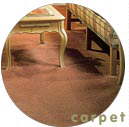Suggestions And Estimations For Buying Carpet
STEP ONE - Pick the right type of fiber. Consider how the
room will be "lived in," then choose from the following fibers:
Nylon is the most popular fiber, perfect for heavy traffic and
active families with children or pets.
Polyester is good for normal traffic, offering a rich, luxurious
feel, stain and fade resistance, great selection of styles and colors.
Olefin is used in many of today's newest looks and is stain
and moisture resistant.
Wool is a natural fiber that will maintain its beauty for a
long time. Wool is found in most of the finest carpets made.
STEP TWO - Choose quality construction.
A well-constructed carpet will retain its beauty and last longer. The
density of the fibers and the twist of the yarn determine durability and
appearance.Twisting gives fiber strands the strength to stand up to foot
traffic and cleaning. The more twists, the better. Density is how tightly
the twisted fibers are packed together. A denser carpet has better durability.
STEP THREE - Consider stain resistance.
Active, high-traffic households with children and pets will want carpet
with superior stain resistance. Many new, improved stain-resisting styles
are available, including DuPont Stainmaster, Wear-Dated II Carpet and ANSO
CrushResister III carpets. The fibers in these carpets actually push away
dirt and spills, reducing their ability to stick to or penetrate the fibers.
STEP FOUR - Select the color.
Think of the floor as the "fifth wall" that connects all other design
elements in the room. Consider walls, window treatments and other furnishings
when choosing color. Buyers should bring fabric and color samples with
them when making carpet color selections. Rooms that lack natural light
can be "warmed up" with sunny yellows, bright oranges and vibrant reds.
Blues and greens can "cool off" a room and add a calm, serene feeling.
Casual rooms such as kitchens and family rooms generally call for lively
colors. More formal settings do well with neutrals and soft pastels for
an elegant look.
STEP FIVE - Estimate the cost.
Square Yards: Multiply the number of square yards by the cost
per square yard. To find square yards, multiply the number of feet in the
length of the room by the number of feet in the width. Divide the total
by 9. NOTE: Add another 10-15% to allow for standard flooring widths, seams
and waste.
Square Feet: Many carpet manufacturers sell carpet by the square
foot, making it easier to calculate how much carpet is needed. Just multiply
the number of feet in the length of the room by the number of feet in the
width. Multiply this number by the cost per square foot. NOTE: Add another
10-15% to allow for standard flooring widths, seams and waste. Remember
to include cushion and installation in your final cost.
 Before shopping for floor covering it will help if you have an idea of
how many square feet / yards that you will need. So feel free to use our
Floor Estimator to Estimate the approximate amount of Floor Covering needed
for your individual rooms, halls or other area(s). You may find it pretty
accurate!
Before shopping for floor covering it will help if you have an idea of
how many square feet / yards that you will need. So feel free to use our
Floor Estimator to Estimate the approximate amount of Floor Covering needed
for your individual rooms, halls or other area(s). You may find it pretty
accurate!
See also links on the Consumer
information page where you can find more info about carpets.


